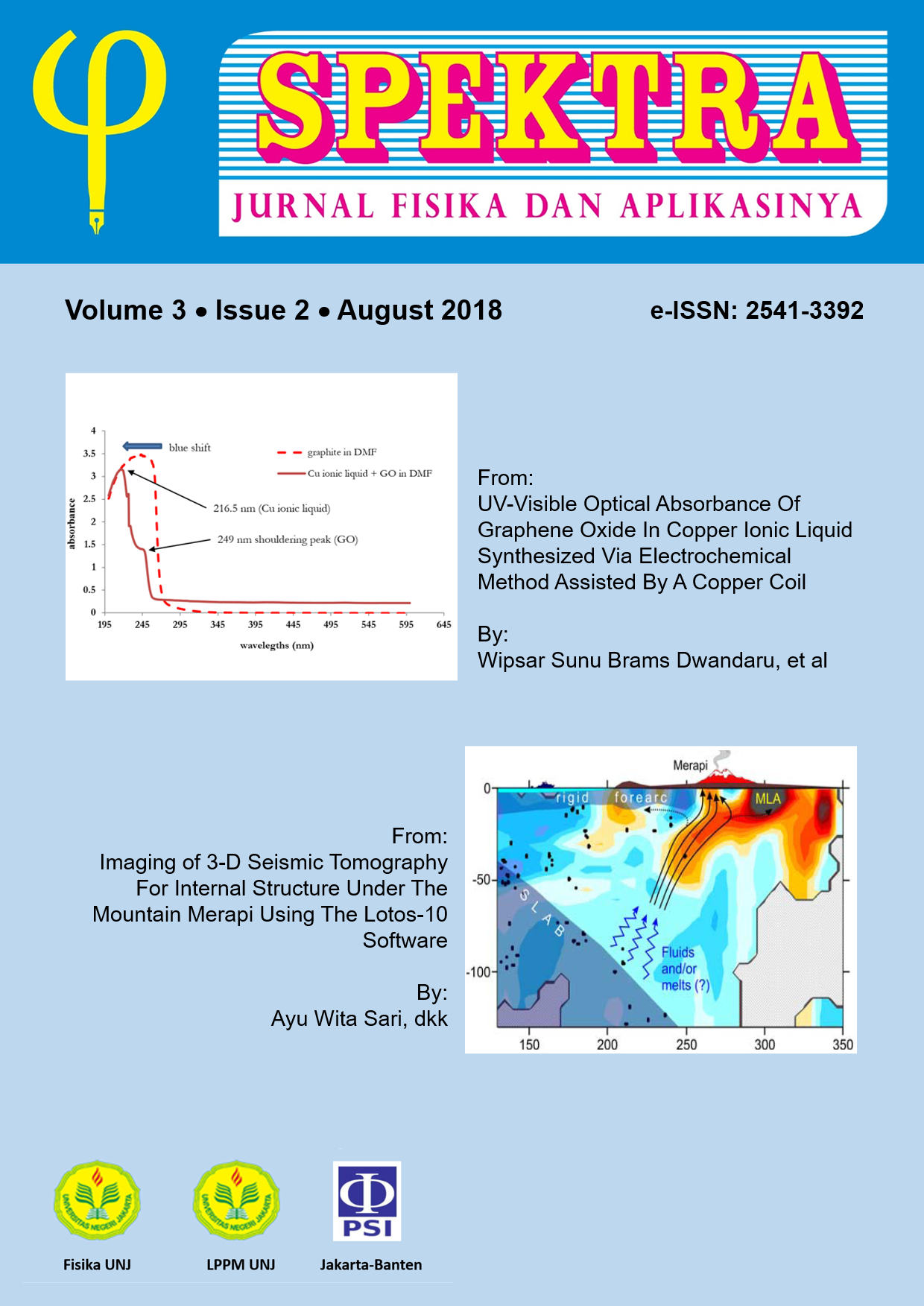ANALOG COMPUTER FOR STUDYING DIATOMIC MOLECULAR SPECTRA IN TERAHERTZ FREQUENCY
DOI:
https://doi.org/10.21009/SPEKTRA.032.06Keywords:
Diatomic Molecule, Optical THz Region, Rotational-Vibrational Transitions, , Harmonic-Oscillator ModelAbstract
This paper introduces a harmonic oscillator model for rovibronic terahertz spectrum of a model of a rigid diatomic rotor with some control parameters. The model shows a study of rotationally-resolved terahertz band spectra of the vibrational transition in diatomic molecules. THz radiation absorption is used as a closed-form system known as the analog computer dynamics mode. The optical terahertz region spectrum of the diatomic molecule consists of a series of lines. Their separations are not exactly constant. A diatomic molecule is not truly a rigid rotator, because it simultaneously vibrates with a small amplitude. Due to quantized vibrational and rotational energy levels and the selection rules, allowed transitions result in a highly ordered spectrum consisting of a P branch separated by a central gap. Adjacent spectral lines are separated by a spacing of 2B, and since line intensities depend on Boltzmann factor for thermal population and quantum number J, each branch monotonically increases and decreases. As temperature increases, more lines are observed, and line intensities decrease due to the population being spread over more rotational levels. Interactivity research also involves on effects of the fundamental vibrational frequency, rotational constant B and temperature included line width on the observed spectrum.
References
[2] G. D. Billing, “Semi-classical calculations of rotational/vibrational transitions in He-H2",†Chemistry Laboratory III, H.C. Ørsted Institute, pp. 534-535, 2010.
[3] U. Thumm et al., “Quantum-beat analysis of the rotational-vibrational dynamics in D2+,†American Physical Society, 40th Annual Meeting of the APS Division of Atomic, Molecular and Optical Physics, pp. 123-124, May 2009.
[4] G. Herzberg. “Forbidden Transitions In Diatomic Molecules: V. The Rotation–Vibration Spectrum Of The Hydrogen-Deuteride (Hd) Molecule,†J. Phys., vol. 38, no. 6, pp. 806–818, 2007.
[5] S. Zhang et al., “Experimental demonstration of near-infrared negative-index metamaterials,†Phys. Rev. Lett., vol. 95, pp. 137-404, 2005.
[6] S. Yu et al., “Terahertz Spectroscopy and Global Analysis of the Bending Vibrations,†Jet Propulsion Laboratory, Pasadena: California Institute of Technology, 2009, pp. 278
[7] X. Zhou et al., “Magic Wavelengths for Terahertz Clock Transitions,“ School of Electronics Engineering & Computer Science, Beijing: Peking University, 2009, pp. 237
[8] G. Geoffrey, “Quantum Chemestry,†Prentice-Hall of Indian Private Limited New Delhi- 110001, second Edition, 1992, pp. l34-136, 196-197
[9] R. Alen, “Process of Spectroscopy in Diatomic Molecules,†The second edition John Wiley & Son, 1978, pp. l256-1257.
[10] B. Norman et al., " Introduction to Infrared and Raman Spectroscopy Third Edition,†Academic Press, Inc. Harcourt Brace Jovanovich, 2006.
[11] Mu-Zi Li and Xue-Bin Bian, “Redshift in High-order harmonic generation
from diatomic molecules in on-Born- Oppenheimer approximationâ€. The 8th International Symposium on Ultrafast Phenomena and Terahertz Waves, OSA, 2016.
[12] G. Z. Kiss et al., “Efficient Numerical Method for Investigating Diatomic Molecules with Single Active Electron Subjected to Intense and Ultrashort Laser Fields,†TIM17 Physics Conference AIP Conf. Proc. vol. 1916, 2017.
[13] Y. Changfeng and W. Zhiwei, “A Universal Analytic Potential Function Applied to Diatomic Molecules,†IEEE 3rd International Conference on Communication Software and Networks, pp. 105-110, 2011.
[14] H. A. Abdallah and H. Y. Abdalllah, "Contrastive studies of potential energy functions of some diatomic molecules." The International Conference and Workshop on Basic and Applied Sciences, 2015.
[15] D. V. Chubukov and L. N. Labzowsky, “Corrigendum to “Ω-doubling and a
limit for the enhancement of the electron EDM effect in diatomic molecules,†Physics Letters A, vol. 379, pp. 803, 2015.
[16] A. Ichihara et al., “Theoretical Study on Isotope-Selective Excitation of Diatomic Molecules by A Terahertz Frequency Comb,†Conference on Lasers and Electro-Optics Pacific Rim (CLEO-PR) 2013.
Downloads
Published
How to Cite
Issue
Section
License
SPEKTRA: Jurnal Fisika dan Aplikasinya allow the author(s) to hold the copyright without restrictions and allow the author(s) to retain publishing rights without restrictions. SPEKTRA: Jurnal Fisika dan Aplikasinya CC-BY or an equivalent license as the optimal license for the publication, distribution, use, and reuse of scholarly work. In developing strategy and setting priorities, SPEKTRA: Jurnal Fisika dan Aplikasinya recognize that free access is better than priced access, libre access is better than free access, and libre under CC-BY or the equivalent is better than libre under more restrictive open licenses. We should achieve what we can when we can. We should not delay achieving free in order to achieve libre, and we should not stop with free when we can achieve libre.
 SPEKTRA: Jurnal Fisika dan Aplikasinya is licensed under a Creative Commons Attribution 4.0 International License.
SPEKTRA: Jurnal Fisika dan Aplikasinya is licensed under a Creative Commons Attribution 4.0 International License.
You are free to:
Share - copy and redistribute the material in any medium or format
Adapt - remix, transform, and build upon the material for any purpose, even commercially.
The licensor cannot revoke these freedoms as long as you follow the license terms.

 E-ISSN 2541-3392
E-ISSN 2541-3392  Focus & Scope
Focus & Scope  Editorial Team
Editorial Team  Reviewer Team
Reviewer Team  Author Guidelines
Author Guidelines  Article Template
Article Template  Author Fee
Author Fee  Publication Ethics
Publication Ethics  Plagiarism Policy
Plagiarism Policy  Open Access Policy
Open Access Policy  Peer Review Process
Peer Review Process  Retraction & Correction
Retraction & Correction  Licensing & Copyright
Licensing & Copyright  Archiving & Repository
Archiving & Repository  Contact
Contact  Mendeley
Mendeley 

